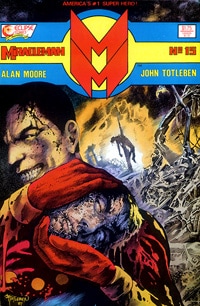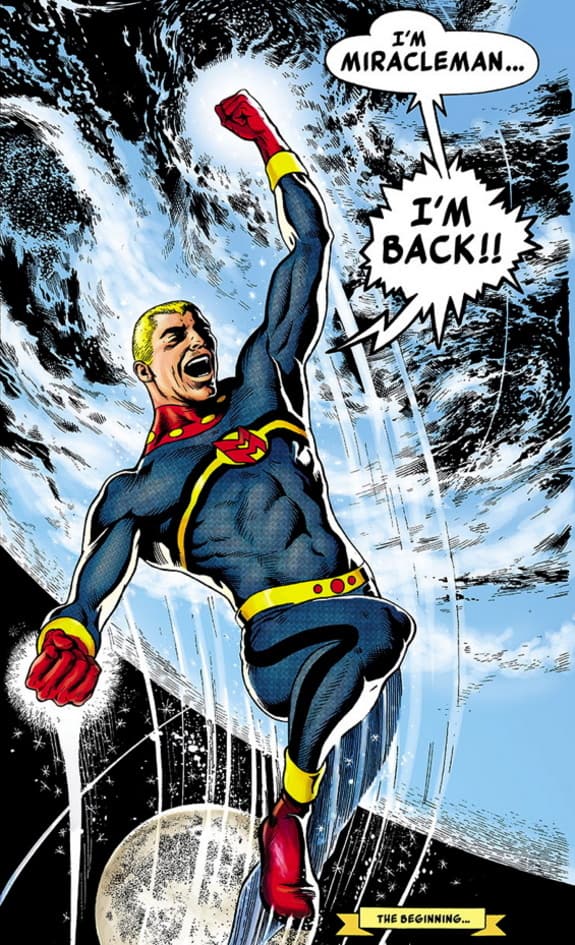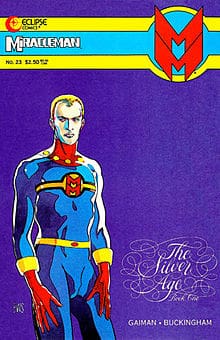Joe Quesada’s tenure as Marvel Editor-in-Chief has proven to be very difficult to judge. It was neither as creatively fertile as Stan Lee’s or Jim Shooter’s tenure, nor was it has disastrous and insolvent as Bob Harras’ term. As with virtually everything in life, Quesada’s tenure is marked by all shades of gray. On the plus side, he greatly increased the circulation of trade paperbacks and pushed for the collectivization of present and previous storylines into graphic novel format. He also called for the establishment of the Ultimate Marvel imprint which helped the company escape bankruptcy. Finally, he brought in extraordinary creative talent like Grant Morrison, Mark Millar, and JMS to bring long suffering books back to respectability.
Conversely, Quesada has also employed, or bore witness to many ideas that not only failed, but rightfully earned the ire of fans as well. He’s pretty much responsible for the increased sedition and marginalization of the X-Men franchise. His feud with Grant Morrison and Alan Moore are the reason why both writers have refused to ever work for Marvel again. Most noticeably, it was his own idea to break up the marriage of Peter Parker and Mary Jane because he personally did not like a married Spider-Man. Against the wishes of literally everyone at Marvel, Quesada also wanted to bring back Gwen Stacy from the dead.
While it seems like all the good he did as Editor-in-Chief occurred during the first half of his run at the position, while the second half was littered with petty decisions that reflected an abuse of power, that’s not exactly the case. Regardless of how much input he had in this decision, one of the coolest things Marvel did under Quesada’s tenure was buying the rights to Miracleman, a character whose name had to be changed from Marvelman at the behest of Marvel Comics.[1]
Unlike Watchmen, V for Vendetta, and Batman: The Killing Joke, his run on Miracleman remains one of Alan Moore’s least publicized work. The only people who have read Miracleman are Alan Moore fans; it’s not treated as a seminal work in comics that every mainstream reader has to read. The 16 issues Moore spent as writer on Miracleman remain one of the best kept secrets in all of comics. Alan Moore is responsible for most Americans’ familiarity with Miracleman, and after decades of legal entanglements and battles over the rights to the character, Marvel stepped in and cleared up any lingering questions over the ownership of the character by simply buying the character’s rights. To really understand and appreciate Marvel’s decision to buy the rights to Miracleman and how considerate it seemed to fans, a brief history of the character is necessary.
Created by Mick Anglo in 1954, Marvelman and his Marvel Family were created as an English substitute for Captain Marvel once Fawcett Comics (owner of Captain Marvel at the time) entered a legal battle over the character with National Comics (soon to be renamed DC Comics). With his magic word of “Kimota” instead of “SHAZAM” and his family consisting of Kid Marvelman, Young Marvelman, and Marvelwoman, Marvelman was at the time nothing more than a carbon copy of Captain Marvel meant to replace the now withdrawn American supply of stories.
After being cancelled in 1963, Marvelman and his family lay dormant for 19 years until a then unknown Alan Moore began his iconic run on the character, re-defining the entire Marvelman mythos. Over the next seven years, Moore would infuse the once cheerful and innocent title with some of the darkest and most brutal stories ever written in comics. Seriously, the final issue of Watchmen, The Killing Joke, and Swamp Thing all have nothing on issues 14-16 of Miracleman. They are some of the most disturbing pieces of literature of I have ever read, but also some of the best.
 In 1985, during Moore’s character-defining run, in order to to avoid further legal squabbles with Marvel Comics, the character’s name was changed to Miracleman, which has remained the name of Mickey Moran’s alter-ego ever since. It was also during this time that the rights for the character changed hands for the umpteenth time, this time going to Eclipse Comics. After numerous and onerous delays, legal battles, and publication issues, Moore finally concluded his 16 issue run in 1989 after seven years of working with the character. Unlike many creators who have no say in who succeeds them on a property, Moore had only one person in mind—Neil Gaiman, who despite having the unenviable task of succeeding Alan Moore on this particularly electric title, delivered an incredibly cerebral and insightful take on the character that served as the perfect and organic continuation of Moore’s originally story. However, the majority of Gaiman’s run never saw the light of day.
In 1985, during Moore’s character-defining run, in order to to avoid further legal squabbles with Marvel Comics, the character’s name was changed to Miracleman, which has remained the name of Mickey Moran’s alter-ego ever since. It was also during this time that the rights for the character changed hands for the umpteenth time, this time going to Eclipse Comics. After numerous and onerous delays, legal battles, and publication issues, Moore finally concluded his 16 issue run in 1989 after seven years of working with the character. Unlike many creators who have no say in who succeeds them on a property, Moore had only one person in mind—Neil Gaiman, who despite having the unenviable task of succeeding Alan Moore on this particularly electric title, delivered an incredibly cerebral and insightful take on the character that served as the perfect and organic continuation of Moore’s originally story. However, the majority of Gaiman’s run never saw the light of day.
Gaiman originally planned to tell the story of the utopia Miracleman had created. His run would have spanned a total of 18 issues with each of the three arcs consisting of six issues each. The only “book” that was ever completed was the first part, “The Golden Age”, which tells the story of the everyday people living in Miracleman’s brave new world. From worshippers beseeching Miracleman at the top of his Olympus, to Miracleman’s attempt to redeem Dr. Gargunza, to the women who were inseminated with Miracleman’s sperm, Neil Gaiman was working on a promising and incredibly poignant tale that expanded the status-quo established by Alan Moore.
The second part of Gaiman’s proposed utopian trilogy was entitled “The Silver Age”, which focused on Young Miracleman’s struggle to acclimate to this new society created by his mentor. It would have begun to sow the seeds of the utopia’s downfall as well as highlight the accelerated culture clash that had arisen as a result of mankind’s rapid and unnatural apotheosis. Unfortunately, due to financial problems only the first two issues of “The Silver Age” were ever published (issues 23-24), with the third issue (#25) completed but never released as Eclipse Comics went out of business in 1993.
For over 20 years, that was the end of Miracleman, his universe, and his story. It was a story that would have assuredly went unfinished, which would have been one of the biggest travesties in all of comic book history. Gaiman’s run ended halfway through and with no resolution in sight, Miracleman was quickly forgotten.
Despite not being published for a few years, Miracleman’s publishing and creative rights became the golden apple of the comic book industry. Gaiman originally claimed he co-owned the character, Todd McFarlane boisterously and incorrectly assumed that he owned the character when he bought out Eclipse Comics[2], then it was revealed that creator Mick Anglo was still the actual owner of the rights to Miracleman all along despite never receiving any royalties from the character. It was pretty much the comic book equivalent of figuring out who was Frankie Lymon’s legal wife.
Bringing an end to the protracted legal wars waged for the rights of Miracleman, Marvel simply bought the rights of the character from Mick Anglo to do as they pleased. It was speculated that Marvel would either integrate the character into Earth-616 or give him his own ongoing series. After all, Marvel is a business first and foremost, they just happen to make comics; they wouldn’t buy a property just to sit on it. As time went by and no news was heard about the fate of Miracleman, many began to wonder what exactly Marvel planned to do with Mickey Moran. Then, in 2013 Joe Quesada broke the big news that beginning in 2014 Marvel would be re-releasing Alan Moore’s run on Miracleman, first in single issue format, then as three separate hardcovers collecting those 16 issues. Furthermore, Marvel actually acquiesced to Alan Moore’s wishes that he not be mentioned by name on any of the re-releases.
As if that weren’t enough of a treat for fans, Marvel then dropped the bombshell on an unsuspecting public—Not only was Marvel going to reprint the Neil Gaiman issues of Miracleman as well, they were going to allow him to complete his initial story. “The Silver Age” would be completed in its entirety and “The Dark Age” would come to fruition. Gaiman would continue on Miracleman as if he never left. Some 23 years later he would be able to finish the story he was forced to abandon halfway through.
The old adage claims that you can never go home again, but here was proof to the contrary. Here was Neil Gaiman getting the chance that no one besides Lebron James ever got, he was able to go home again and finish what he started. I understand that Marvel wouldn’t do this if they didn’t think they could make money from it, but this was such a move made strictly for the fans. Unless someone was a fan of the character, why would they care that Neil Gaiman was going to finish a 22-year-old story about an obscure Captain Marvel twin who only ever mattered in England? Buying the rights to Miracleman may have been a business move, but allowing Neil Gaiman to complete his take on the character was a move made purely for the fans. In a time where Marvel has operated more like a money making corporation than ever before, for them to do this on behalf of the fans is just cool. There’s no other word to describe it; it’s just the coolest thing they’ve done since they let Grant Morrison give the X-Men franchise a face-lift.
Since the cancelation of Miracleman with issue #24 back in 1993, rumors have swirled about what was to come in the series under Neil Gaiman. Thanks to the omniscience of the internet, issue 25 has been revealed online which leaves only the last half of “The Silver Age” a mystery. According to rumors, “The Dark Age” would have dealt with the return of the psychotic Kid Miracleman and the destruction of Miracleman’s utopia. His run would have then ended in a titanic battle inspired by The Revelation to John which would have made their battle in issue 16 seem like a mere squabble. Ultimately, his run would have focused on the utopia as its main character with “The Golden Age” highlighting the successes and miracles of it, “The Silver Age” presenting the decline of the utopia, and then culminating with its destruction in “The Dark Age”.
But these are all rumors, and thankfully the truth behind these musings will be revealed soon enough. After 23 years readers will see how “The Silver Age” plays out and what “The Dark Age” has in store for the Miracleman family. As someone who just discovered Miracleman over the past 12 months, I can easily say that this is the series I’m most excited for in 2016. The story that Alan Moore was able to craft and how Neil Gaiman continued that story in a fully engaging and organic way is one of my favorite comic book stories ever. It’s essentially one gigantic story that chronicled the rise and fall of Mickey Moran/Miracleman. For fans of the character and the work that those two incredibly talented and creatively rich writers did with the character, the news that Gaiman is going to finish his story where he originally left off is the sweetest treat that Marvel has given readers in a long, long time.
In the midst of all these reboots, re-launches, and creative shakeups to spike up sales, it seems that over the past decade or so, comics have lost some of their soul to commercialism. Between DC’s New 52, the upcoming and mysterious Rebirth, and Marvel’s relentless onslaught of Marvel Now, All-New Marvel Now, All New All Different Marvel Now, and All-New All-Different Marvel, the Big Two aren’t really making attempts anymore to disguise the fact that they’re just trying to suck money out of your wallet. But amidst these superfluous re-launches and endless waves of new #1 issues Marvel has preserved some of its integrity by righting the injustice that was done 23 years ago by allowing Neil Gaiman to resume what he called the “big incomplete book of my life”. Under Joe Quesada, Marvel has done a lot of good things, both in creative and financial terms, this was just the coolest.
[1] It’s interesting to note that even once under the ownership of Marvel, the character’s name remained “Mircaleman”.
[2] The rights to Miracleman were pretty much the only rights not included in the sale to McFarlane.



